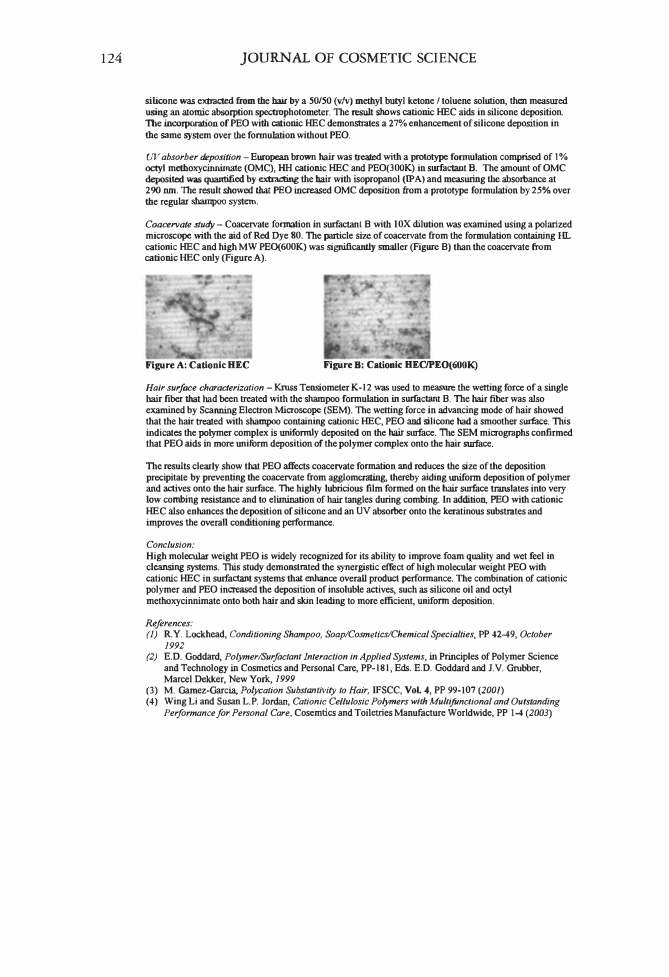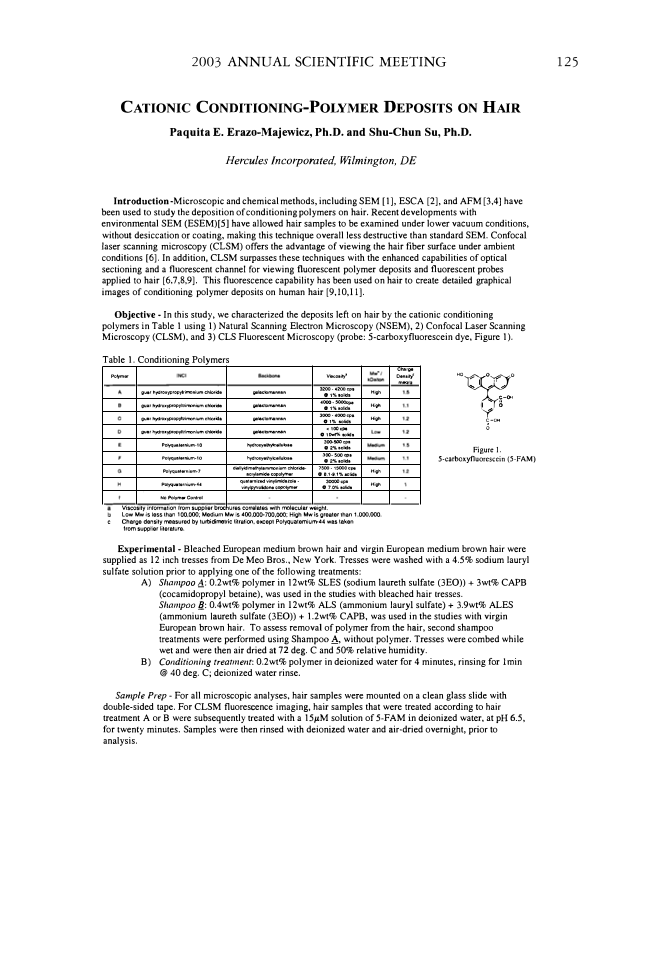124 JOURNAL OF COSMETIC SCIENCE silicone was extracted from the hair by a 50/50 (v/v) methyl butyl ketone / toluene solution, then measured using an atomic absorption spectrophotometer. The result shows cationic HEC aids in silicone deposition. 1be incorporation of PEO with cationic HEC demonstrates a 27% enhancement of silicone deposition in the same system over the fonnu1ation without PEO. UV absorber deposition - Ewope.an brown hair was treated with a prototype formulation comprised of l % octyl methoxycinnimate (OMC), HH cationic HEC and PEO(300K) in surfactant B. The amount of OMC deposited was quantified by extracting the hair with isopropanol (IP A) and measuring the absoxbance at 290 nm. The result showed that PEO increased OMC deposition from a prototype formulation by 25% over the regular shampoo system. Coacervate study- Coacervate formation in surfactant B with l0X dilution was examined using a polarized microscope with the aid of Red Dye 80. The particle size of coacervate from the formulation containing Ill.. cationic HEC and high MW PE0(600K) was significantly smaller (Figure B) than the coacervate from cationic HEC only (Figure A). Figure A: Cationic HEC Figure B: Cationic HEC/PEO(600K) Hair surface characterization -Kruss Tensiometer K-12 was used to measure the wetting force of a single hair fiber that had been treated with the shampoo formulation in sUifactant B. The hair fiber was also examined by Scanning Electron Microscope (SEM). The wetting force in advancing mode of hair showed that the hair treated with shampoo containing cationic HEC, PEO and silicone had a smoother surface. This indicates the polymer complex is uniformJy deposited on the hair surface. The SEM micrographs confirmed that PEO aids in more uniform deposition of the polymer complex onto the hair surface. The results clearly show that PEO affects coacervate formation and reduces the size of the deposition precipitate by preventing the coacervate from agglomerating, thereby aiding uniform deposition of polymer and actives onto the hair surface. The highly lubricious film formed on the hair surface translates into very low combing resistance and to elimination of hair tangles during combing. In addition, PEO with cationic HEC also enhances the deposition of silicone and an UV absorber onto the keratinous substrates and improves the overall conditioning performance. Conclusion: High molecular weight PEO is widely recognized for its ability to improve foam quality and wet feel in cleansing systems. This study demonstrated the synergistic effect of high molecular weight PEO with cationic HEC in surfactant systems that enhance overall product performance. The combination of cationic polymer and PEO increased the deposition of insoluble actives, such as silicone oil and octyl methoxycinnimate onto both hair and skin leading to more efficient, uniform deposition. References: (]) R.Y. Lockhead, Conditioning Shampoo, Soap/Cosmetics/Chemical Specialties, PP 42-49, October 1992 (2) E.D. Goddard, Polymer/Surfactant Interaction in Applied Systems, in Principles of Polymer Science and Technology in Cosmetics and Personal Care, PP-181, Eds. E.D. Goddard and J.V. Grubber, Marcel Dekker, New York, 1999 (3) M. Gamez-Garcia, Pol yc ation Substantivity to Hair, IFSCC, Vol. 4, PP 99-107 (2001) ( 4) Wing Li and Susan L.P. Jordan, Cationic Ce//ulosic Polymers wllh Multifanclional and Outstanding Performance for Personal Care, Cosemtics and Toiletries Manufacture Worldwide, PP 1-4 (2003)
2003 ANNUAL SCIENTIFIC MEETING CATIONIC CONDITIONING-POLYMER DEPOSITS ON HAIR Paquita E. Erazo-Majewicz, Ph.D. and Shu-Chun Su, Ph.D. Hercules Incorporated, Wilmington, DE Introduction -Microscopic and chemical methods, including SEM [l], ESCA [2], and AFM [3,4] have been used to study the deposition of conditioning polymers on hair. Recent developments with environmental SEM (ESEM)[5] have allowed hair samples to be examined under lower vacuum conditions, without desiccation or coating, making this technique overall less destructive than standard SEM. Confocal laser scanning microscopy (CLSM) offers the advantage of viewing the hair fiber surface under ambient conditions [ 6]. In addition, CLSM surpasses these techniques with the enhanced capabilities of optical sectioning and a fluorescent channel for viewing fluorescent polymer deposits and fluorescent probes applied to hair [6,7,8,9]. This fluorescence capability has been used on hair to create detailed graphical images of conditioning polymer deposits on human hair [9,10,11]. Objective - In this study, we characterized the deposits left on hair by the cationic conditioning polymers in Table l using 1) Natural Scanning Electron Microscopy (NSEM), 2) Confocal Laser Scanning Microscopy (CLSM), and 3) CLS Fluorescent Microscopy (probe: 5-carboxyfluorescein dye, Figure 1). Table 1. Conditioning Polymers Polymer guarhydtOX)IPtOpyltrimoniumchloride guarhydroxypropyltrirnoniumchlolide guar hydroxypropyltrimoniumchlorida guathydro:.:ypropyttrimoniumchiofide Potyqualernium-10 Po1yqualernium-1O Polyqualernium-7 Potrqualarnium-44 No Polym• Control galaclomannan gale.etomannan gale.clomannan gale.ctomannan hydtoxyalhylc:elluloae hydro:.:yelhylcatlulosa Viscoaity 1 3200-4200cpa 01%1olids 4000-- 01%solids 3000-4000Cp8 01% solids 100cps 0 1 Owt% solid a 300-SOOcpa 02%aolida 300-SOOcpa 02%aolida diallyldimethylammoniumchloride- 7500-1,000cps acrylamidecopolymer oe.,-9.1%solida quatarnizedvinylimldazole- 30000cpa \Jinylpyrroidonecopolymer 07.0%aolida High High High High High Charge Density' meal• HOU1�0, ,,. o "' /, /, C-0-t I : 0 C-OH 0 Figure I. 5-carboxyfluorescein (5-FAM) Viscosity 1nlormat1on from supplier brochures correlates with molecular weight. Low Mw is less than 100,000 Medium Mw is 400,000-700,000 High Mw is greater than 1,000,000. c Charge density measured by turbidimetric titration, except Polyquatemium-44 was taken from supplier literature. Experimental - Bleached European medium brown hair and virgin European medium brown hair were supplied as 12 inch tresses from De Meo Bros., New York. Tresses were washed with a 4.5% sodium lauryl sulfate solution prior to applying one of the following treatments: A) Shampoo A: 0.2wt% polymer in 12wt% SLES (sodium laureth sulfate (3EO)) + 3wt% CAPB (cocamidopropyl betaine), was used in the studies with bleached hair tresses. Shampoo fl_: 0.4wt% polymer in 12wt% ALS (ammonium lauryl sulfate)+ 3.9wt% ALES (ammonium laureth sulfate (3EO)) + l.2wt% CAPB, was used in the studies with virgin European brown hair. To assess removal of polymer from the hair, second shampoo treatments were performed using Shampoo A, without polymer. Tresses were combed while wet and were then air dried at 72 deg. C and 50% relative humidity. B) Conditioning treatment: 0.2wt% polymer in deionized water for 4 minutes, rinsing for lmin @ 40 deg. C deionized water rinse. Sample Prep - For all microscopic analyses, hair samples were mounted on a clean glass slide with double-sided tape. For CLSM fluorescence imaging, hair samples that were treated according to hair treatment A or B were subsequently treated with a 15µM solution of 5-FAM in deionized water, at pH 6.5, for twenty minutes. Samples were then rinsed with deionized water and air-dried overnight, prior to analysis. 125
Purchased for the exclusive use of nofirst nolast (unknown) From: SCC Media Library & Resource Center (library.scconline.org)





































































































































